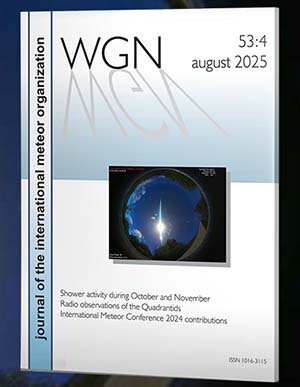Accoding to the below, very first analysis of the 2004 Perseids, the additional activity peak near 21h UT on August 11, 2004, was confirmed by visual observations sent to the IMO. Particle simulations predicted that this peak is caused by material ejected from Comet Swift-Tuttle at its perihelion passage in 1862 (1-revolution dust trail).
There is not enough data yet to fix the time and level of the traditional Perseid maximum expected for near 10h UT on August 12. The peak time of the 1-rev dust trail will probably be fixed with an accuracy of 10 minutes soon.
We are most grateful to the observers who have contributed so far to the analysis (observing periods have been selected to get a reasonable coverage — complete input will be done in the next hours):
Rainer Arlt (Germany), Roberto Bacci (Italy), Lukas Bolz (Germany), Michael Boschat (Canada), Sietse Dijkstra (the Netherlands), Audrius Dubietis (Lithuania), Andre Knofel (Germany), Dovile Kraulaidiene (Lithuania), Ralf Kuschnik (Germany), Marco Langbroek (the Netherlands), Mike Linnolt (USA), Robert Lunsford (USA), Vladimir Lukic (USA), Hartwig Luthen (Germany), Felix A. Martinez (USA), Sirko Molau (Germany), Norman W. McLeod (USA), Sven Nather (Germany), Daniel van Os (the Netherlands), Jurgen Rendtel (Germany), Petra Rendtel (Germany), Oliver Wusk (Germany), Jurga Zieniute (Lithuania)
------------------------------------------------------ Date (UT) Time Solarlong nINT nPER ZHR ------------------------------------------------------ Aug 11.35 08:24 138.943 6 137 37 +- 3 Aug 11.85 20:24 139.423 27 271 141 +- 9 Aug 11.87 20:53 139.443 19 174 185 +- 14 Aug 11.88 21:07 139.452 11 101 187 +- 19 Aug 11.89 21:22 139.462 8 30 131 +- 24 Aug 11.90 21:36 139.471 14 63 86 +- 11 Aug 11.91 21:50 139.481 8 16 48 +- 12 Aug 11.92 22:05 139.491 6 74 79 +- 9 Aug 11.96 23:02 139.529 9 136 87 +- 7 Aug 12.01 00:14 139.577 13 137 99 +- 8 Aug 12.04 00:58 139.606 20 236 126 +- 8 Aug 12.08 01:55 139.644 10 129 110 +- 10 Aug 12.26 06:14 139.817 4 151 59 +- 5 Aug 12.47 11:17 140.019 8 33 121 +- 21 ------------------------------------------------------ r = 2.0 was used. Solar longitudes refer to J2000.0




 You saw something bright and fast? Like a huge shooting star? Report it: it may be a fireball.
You saw something bright and fast? Like a huge shooting star? Report it: it may be a fireball.  You counted meteors last night? Share your results with us!
You counted meteors last night? Share your results with us!  You took a photo of a meteor or fireball? You have a screenshot of your cam? Share it with us!
You took a photo of a meteor or fireball? You have a screenshot of your cam? Share it with us!  You caught a meteor or fireball on video? Share your video with us!
You caught a meteor or fireball on video? Share your video with us!